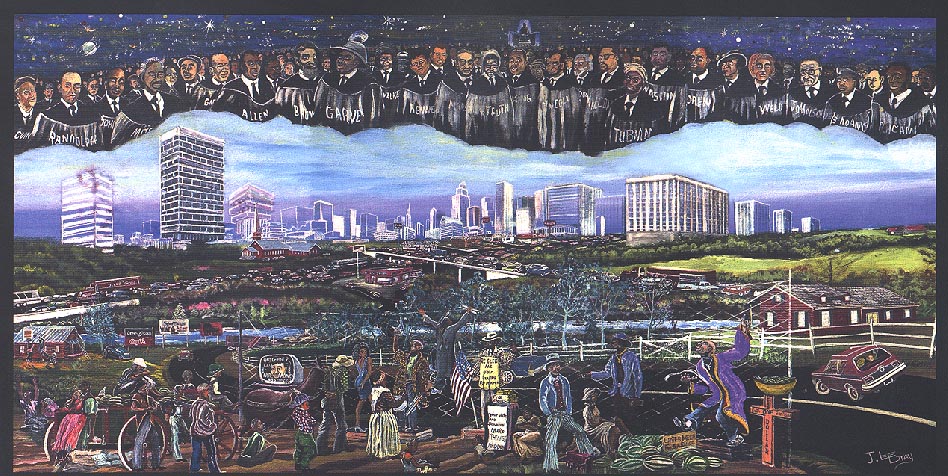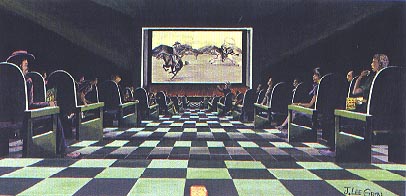

| For more information about this article or gallery, please call the gallery phone number listed in the last line of the article, "For more info..." |
February Issue 2004
SC State Museum in Columbia, SC, Features Works by Johnnie Lee Gray

During his lifetime, the self-taught artist Johnnie Lee Gray (1941-2000) was known only regionally, in and around his hometown of Spartanburg, SC. Since Nov. 2002, however, a trove of his previously unheralded paintings has been touring the country to acclaim.
Now the exhibition, Rising Above Jim Crow: The Paintings of Johnnie Lee Gray, has come home to South Carolina for the final showing of its tour. Encompassing some 35 paintings, as well as archival photographs and videotaped interviews that put the artwork into context, Rising Above Jim Crow, is on view at the South Carolina State Museum in Columbia, SC, through Apr. 11, 2004.
 When
the exhibition originated in 2002 at the Schomburg Center for
Research in Black Culture, a branch of the New York Public Library,
The Wall Street Journal wrote that "Gray's images
do not take long to work their way into the imagination. For all
that separates him from so exalted a figure as Toni Morrison,
the Nobel Prize-winning novelist, the hitherto unsung folk artist
of Spartanburg is her country cousin." Now museum goers in
South Carolina will have their opportunity to experience the exhibition's
unforgettable personal vision of the strength and creativity of
African-American life during the final decades of segregation.
When
the exhibition originated in 2002 at the Schomburg Center for
Research in Black Culture, a branch of the New York Public Library,
The Wall Street Journal wrote that "Gray's images
do not take long to work their way into the imagination. For all
that separates him from so exalted a figure as Toni Morrison,
the Nobel Prize-winning novelist, the hitherto unsung folk artist
of Spartanburg is her country cousin." Now museum goers in
South Carolina will have their opportunity to experience the exhibition's
unforgettable personal vision of the strength and creativity of
African-American life during the final decades of segregation.
Rising Above Jim Crow is sponsored by New York Life Insurance Company, which was also the sole corporate underwriter of the four-part WNET New York series The Rise and Fall of Jim Crow, broadcast in 2002-2003 on PBS.
"New York Life Insurance Company is pleased to sponsor Rising Above Jim Crow: The Paintings of Johnnie Lee Gray as part of our ongoing commitment to educational initiatives in the communities where we do business," states Sy Sternberg, chairman and chief executive officer. "It is not only those who lived during the Jim Crow era who were affected by it. This chapter of American history directly influenced art, literature, music, and popular culture. Our sponsorship of this exhibition and of the landmark television event The Rise and Fall of Jim Crow creates the opportunity to reflect on the past, to better understand the present, and to shape the future."
"We are honored to showcase the important works of a local artist who vividly captured the African-American experience during the Jim Crow years," says State Museum Curator of Art Paul Matheny. "Johnnie Lee Gray painted scenes of African-American culture in a method unlike anything I've ever seen."
In association with the television series, New York Life has underwritten an educational web site, (www.jimcrowhistory.org) aimed at enhancing and extending the teaching of this historical era in schools nationwide. The paintings of Gray came to national attention through the development of the web site, when researchers were directed to Gray's widow, Shirley Sims Gray, whose collection of her late husband's work forms the core of the exhibition. Rising Above Jim Crow has been posted on the web site, to enable teachers to incorporate these images into their lesson plans.
Johnnie Lee Gray was born on August 18, 1941, outside Spartanburg, South Carolina, about 100 miles northwest of the state capital of Columbia. After losing his father to a car accident, he went at the age of five to live with his grandparents, who were sharecroppers. While still a child, he worked in the fields as water boy during peach and cotton harvests. He also began to draw at an early age, amusing himself during the long hours he spent alone while his grandparents were in the fields and his mother, a housekeeper, was at work. "Johnnie's family was so poor they couldn't afford to buy him anything," comments his widow Shirley Sims Gray. "So when he wanted something, he'd draw it, and that way he could make it his." As his other pastimes, he listened to the radio and read voraciously, activities that fed his imagination.
Gray attended the county's segregated high school for African-Americans, Lincoln High School, where his classmates and teachers recognized his artistic talent and put him in charge of billboards and displays. During this time, he received his only formal training as an artist, from a correspondence course advertised in a magazine. His only self-portrait dates from this period and shows him in cap and gown-a substitute for the graduation photograph that his family could not afford.
Upon graduating from high school in 1960, Gray joined the Army. He served for seven years, including an 18-month tour of duty in Vietnam. After his discharge, he returned to South Carolina, where he found work in the textile mills and as a carpenter. He continued to draw, however, and to identify himself an artist. This was the claim he made in 1978 when he met Shirley Sims, a Spartanburg native who was trained as a science teacher and cell biologist, but was working for a regional insurance company. Wanting to decorate the doors of her living room, she commissioned Gray's first paintings. Three weeks after he began the assignment, Johnnie Lee Gray married Shirley Sims.
At first, Gray painted on canvas, using acrylics. Blue dominated the palette of many of his paintings, since it was the least costly color to buy. He also used colors left over from housepainting jobs, or would mix pigments of his own from local clays. When money was short for canvas, he would paint on sheets of treated plywood left over from his carpentry jobs-a surface that he came to prefer for his work. "He used whatever came to hand," says Mrs. Gray. Often he worked on several pictures simultaneously, putting one or another aside for weeks and then returning to it when inspiration struck.
 Gray
ultimately completed approximately 150 paintings. Although they
encompass devotional images, landscapes, abstractions, and pictures
about Africa, most of his works are autobiographical, dealing
with the subjects he knew best: daily life during the last years
of the Jim Crow era, social change in the South, his experience
of the Vietnam War, and those historic events (the Civil War,
the triumph of the Tuskegee Airmen) that he felt affected his
life.
Gray
ultimately completed approximately 150 paintings. Although they
encompass devotional images, landscapes, abstractions, and pictures
about Africa, most of his works are autobiographical, dealing
with the subjects he knew best: daily life during the last years
of the Jim Crow era, social change in the South, his experience
of the Vietnam War, and those historic events (the Civil War,
the triumph of the Tuskegee Airmen) that he felt affected his
life.
Gray received encouragement in his work from two local African-American artists, Raymond Floyd and Thomas Parham, who were impressed by the recognizable, personal style he had developed. He also felt encouraged when he applied to take a studio art class at the University of South Carolina at Spartanburg and was told he should be a teacher. A small market for Gray's artwork developed in Spartanburg, where he would occasionally enter his paintings in local shows and win awards. He sold pictures for prices ranging from $25 to $100. Also, on one occasion, a friend took three of his works to New York City. With that exception, however, his work was known chiefly within the Spartanburg community.
Gray was diagnosed with lung cancer in January 2000. After a four-week hospital stay, he returned home and set about painting feverishly, continuing to paint until he was no longer able to hold a brush. He died on Apr. 27, 2000.
Rising Above Jim Crow: The Paintings of Johnnie Lee Gray is curated by Dr. Gwendolyn H. Everett, a former staff member of the Smithsonian American Art Museum and author of the award-winning children's book Li'l Sis and Uncle Willie. Dr. Everett currently teaches art history at Howard University. Written materials for the exhibition have been created by Dr. Everett and Dr. Todd Steven Burroughs, a former national correspondent and news editor of the NNPA News Service, who has written for publications including The Source, The Crisis, Africana.com, The Amsterdam News (New York), and the Newark Star-Ledger.
New York Life Insurance Company, a Fortune 100 company, is the largest mutual life insurance company in the United States and one of the largest life insurers in the world. Founded in 1845 and headquartered in New York City, New York Life offers life insurance, and through its affiliates, annuities, and long-term care insurance. New York Life Investment Management, LLC, a New York Life affiliate, provides institutional asset management, retirement planning, and trust services. Other New York Life affiliates provide an array of securities products and services, as well as institutional and retail mutual funds. Visit New York Life's Web site at (www.newyorklife.com) for more information.
For more information
check our SC Institutional Gallery listings, call the museum
at 803/898-4921 or on the web at (www.museum.state.sc.us).
Carolina Arts is published monthly by Shoestring Publishing
Company, a subsidiary of PSMG, Inc.
Copyright© 2004 by PSMG, Inc., which published Charleston
Arts from July 1987 - Dec. 1994 and South Carolina Arts
from Jan. 1995 - Dec. 1996. It also publishes Carolina Arts
Online, Copyright© 2004 by PSMG, Inc. All rights reserved
by PSMG, Inc. or by the authors of articles. Reproduction or use
without written permission is strictly prohibited. Carolina
Arts is available throughout North & South Carolina.